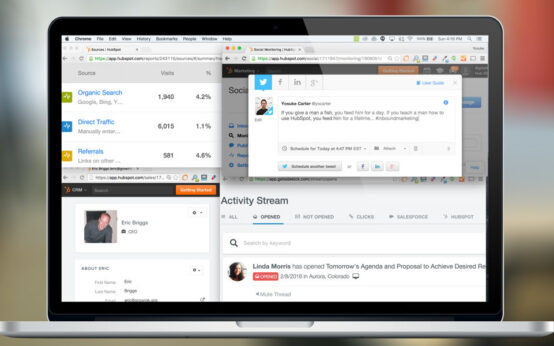Forget the contrived name – omni channel content marketing is simply the approach of viewing your content strategy as essentially “channel-less.” So instead of creating one content plan for your social media, and then another for your email marketing (and so-on), you instead look at the bigger picture – what are the key messages your audience want to hear from you? What do they care about? Where does that intersect with what you offer as a brand? Your omni-channel content strategy should answer these questions first. That way, you can develop a content plan that ensures all of your channels communicate the same core themes that your audience will value – with strong content at its heart.
The next step is to map out the customer journey – where and when does your audience interact with your brand? With your new “channel-less” top-level content marketing strategy at hand, you’ll be able to see where and when those core messages make most sense – for example, teasing a new product launch on social media, but then really hammering the message home on email marketing, with far more transactional messaging.
Unleashing omni channel potential
Thinking about your content in an “omi channel” way can create a seamless, personalised experience for your audience across all touchpoints – treating them to a cohesive journey no matter where they hop, skip, or click.
For small businesses and big-league marketers alike, mastering this strategy can unlock a treasure trove of opportunities. In order to do so, it’s essential to consider the following in your strategy:
- Understand your customer journeys: Even if your business does not have hefty budgets, you do have one ace up your sleeve – knowing your customers intimately. Picture this: a local bakery engaging customers through Instagram, leading them to a user-friendly website for orders, then surprising them with a personalised thank-you note in their physical purchases. It’s about mapping the journey and being where the customers are, offering a consistent and delightful experience. Remember to focus – this omi channel approach isn’t about being everywhere. It’s about figuring out where your audience or customer base already is, and bringing those channels into your core mix. For example, there’s probably no need to be creating content for TikTok if you’re a B2B consultancy.
- Fully integrate your key marketing platforms: businesses small and large can maximise their impact by integrating their key marketing platforms. From seamlessly linking social media engagement to website sales or using email campaigns that resonate with in-store promotions, it’s about making every platform play in harmony to amplify the brand message. Consider where each touchpoint sits in that user journey you’ve explored – while your customers may love hearing about your new products on Instagram, for example, they may not be likely to actually buy it on that platform. Use Instagram for that first teaser message, then you can slowly get more “salesy” as your audience gets closer to a purchase – like when they land on a product page on your website.
- Leverage data for ultimate personalisation: Your businesses might not have tons of data, but an omni channel strategy with valuable content at its heart means you can collect and leverage insights to create personalised experiences. Think of a neighborhood bookstore offering curated recommendations based on a customer’s online browsing history or purchase patterns. It’s all about making the customer feel seen and understood. How? Ask questions in your content. Be conversational. Maybe you could run polls on your social media? Which products are people enjoying? What do they want to see more of from your brand? Then use that qualitative information in the rest of your omni channel strategy – those insights gained from social media could help you write better-tailored product pages or emails.
Learn from the titans: some well-known successful omni channel content strategies”
- IBM’s integrated approach: IBM’s prowess lies in seamlessly weaving its offerings across various channels. Imagine their digital presence—informative blog posts, engaging social media updates, and a website designed for easy navigation. But here’s the kicker: their physical events and seminars sync flawlessly with their online content, creating a cohesive experience.
- McDonald’s global integration: The Golden Arches have mastered the art of omni channel content marketing across borders. Their mobile app offers personalised deals, while their in-store kiosks sync with the app for easy ordering. Plus, their loyalty program bridges the gap between online and offline, rewarding customers no matter where they engage. This is done using a highly personalised approach – copy and content is crafted using information on a customer’s known preferences wherever possible. Does the customer love a Big Mac? Or are they likely vegetarian? Are there new promotional items available at restaurants near them? The content each customer sees will be highly tailored in this way, no matter which channel they engage with the McDonald’s brand on.
- Spotify’s personalised melody: Spotify’s magic lies in curating playlists that feel tailor-made for each user. Their platform seamlessly shifts from mobile to desktop, ensuring users never miss a beat. Plus, their personalised emails and push notifications recommend new music or suggest concert tickets, turning every interaction into a personalised experience. The yearly Spotify Wrapped campaign is a great example of this. Spotify uses data on listening habits to deliver, honestly, best-in-class content marketing – first via email and pop-ups in the Spotify app, then via a dedicated landing page, and finally (here’s the genius bit), by supplying the user with their own personal social media cards for them to share. If anyone’s nailed the use of omni channel content planning to get its user base massively amplifying their campaign reach, it’s Spotify.
Best practices and takeaways
- Consistency is key: Whether a small business or a global brand, consistency across platforms is non-negotiable. It’s about maintaining a cohesive brand voice and experience, ensuring customers feel at home, no matter where they engage.
- Data is the Holy Grail: The power of data cannot be overstated. Collecting and leveraging customer insights fuels the personalisation engine, turning every interaction into a tailored experience. Remember, this doesn’t have to mean generating and analysing masses of data – that simple example of social media polls could be a great place to start.
- Seamless integration for success: Integrating platforms, systems, and teams is crucial. It’s the fusion of digital and physical, online and offline, sales and service that creates a symphony of experiences.
Omni channel content strategies wield immense power, leveling the playing field for small businesses and propelling global giants to new heights. It’s about embracing a content-first, “channel-less” mindset – seamless, personalised, and all-encompassing. Whether it’s a local bakery or a tech titan, the key is to make every customer journey a delightful adventure.
10-step guide to creating an omni channel content strategy:
Step 1: Define your goals and objectives
Begin by establishing clear and measurable goals for your content marketing efforts. Identify what you want to achieve, whether it’s brand awareness, lead generation, or customer retention. Define specific objectives that align with your overall business strategy.
Step 2: Understand your target audience
Create personas, in as much detail as you can, to understand your target audience’s preferences, pain points, and behaviours. This insight will guide your content creation, ensuring it resonates with your audience across different channels. For big businesses, that’s about leveraging as much data as possible from as many channels as possible.
For a smaller business, that may be more about picturing your regular customers in person – what are they like? What do they enjoy? What times do they shop at? What are their hobbies and interests? Do these people tend to fall into a few different categories (e.g. the early shoppers, the deal-lovers etc?). Try and create at least three core personas – give them names (e.g. “Deal-loving Dave”). Picture Dave every time you create content pushing those deals – his likes, dislikes, etc.
Step 3: Evaluate your existing content
Review your existing content to identify gaps and opportunities. Analyse which content has performed well in the past and understand the topics and formats that resonate with your audience. Does it really give “Deal-loving Dave” et al what they want, need, or expect? This will inform your strategy moving forward.
Step 4: Develop a channel-agnostic content calendar
Create a content calendar that outlines your planned content. Ensure flexibility, allowing you to adapt content for different platforms while maintaining a consistent brand voice and message. The calendar should cover various content types, such as blog posts, videos – whatever you think those personas will find valuable and that lend themselves to the message you’re delivering. Remember – think “content first,” then channel.
Step 5: Craft versatile content
Create content that can be easily adapted to different channels without losing its essence. Develop evergreen content that remains relevant over time and repurpose it for various platforms. Ensure that each piece aligns with your brand and messaging strategy.
Step 6: Optimise, optimise, optimise
Optimise your content to enhance its discoverability. What does that mean? For website content, use relevant keywords and create compelling meta-descriptions. For social media, it means using relevant hashtags, tagging collaborators, and keeping your content to the optimal length. And remember to go back and do the same for your existing content – could that blog post from last month be better optimised? Could the last social media video you posted be re-cut or repurposed? Implementing these best practices ensures that your content reaches the broadest audience possible while remaining highly relevant and valuable.
Step 7: Leverage visual content
Incorporate visual elements like images, infographics, and videos to enhance engagement. Visual content tends to perform well across different channels and can convey complex information more effectively.
Step 8: Focus on consistent branding
Maintain a consistent brand identity across all channels. From visuals to tone of voice, ensure that your brand is easily recognisable, fostering trust and loyalty among your audience.
Step 9: Monitor and analyse performance
Regularly track the performance of your content across different channels. Use analytics tools to measure key performance indicators (KPIs) and adjust your strategy based on the data. Identify what works best and refine your approach accordingly. There’s a host of free tools – e.g. Google Analytics for website data, AHRefs for SEO – that can at least get you started if your brand or business is on the smaller side or just starting out.
Step 10: Adapt, adopt, and improve
A channel-agnostic content marketing plan is an evolving strategy. Continuously gather feedback, stay updated on industry trends, and be ready to adapt your plan to meet changing audience needs and preferences. Could you adopt an omni channel informational approach like IBM’s? Could you adapt Spotify’s Wrapped campaign in a fun or cheeky way that might resonate with your audience? Be open to testing new ideas as well as closely monitoring what resonates with your existing audience or customer base.
By following this step-by-step guide, you’ll be well on your way to creating an omni channel content marketing plan that maximises your reach and resonates with your target audience across all relevant platforms.



 10 amazing content marketing examples
10 amazing content marketing examples  Inbound content marketing – what is it and how does it work?
Inbound content marketing – what is it and how does it work?  The problem with defining “content strategy”
The problem with defining “content strategy”  How effective is content marketing?
How effective is content marketing?  Is AI a content marketer’s friend or foe?
Is AI a content marketer’s friend or foe?  What is attraction content marketing?
What is attraction content marketing?